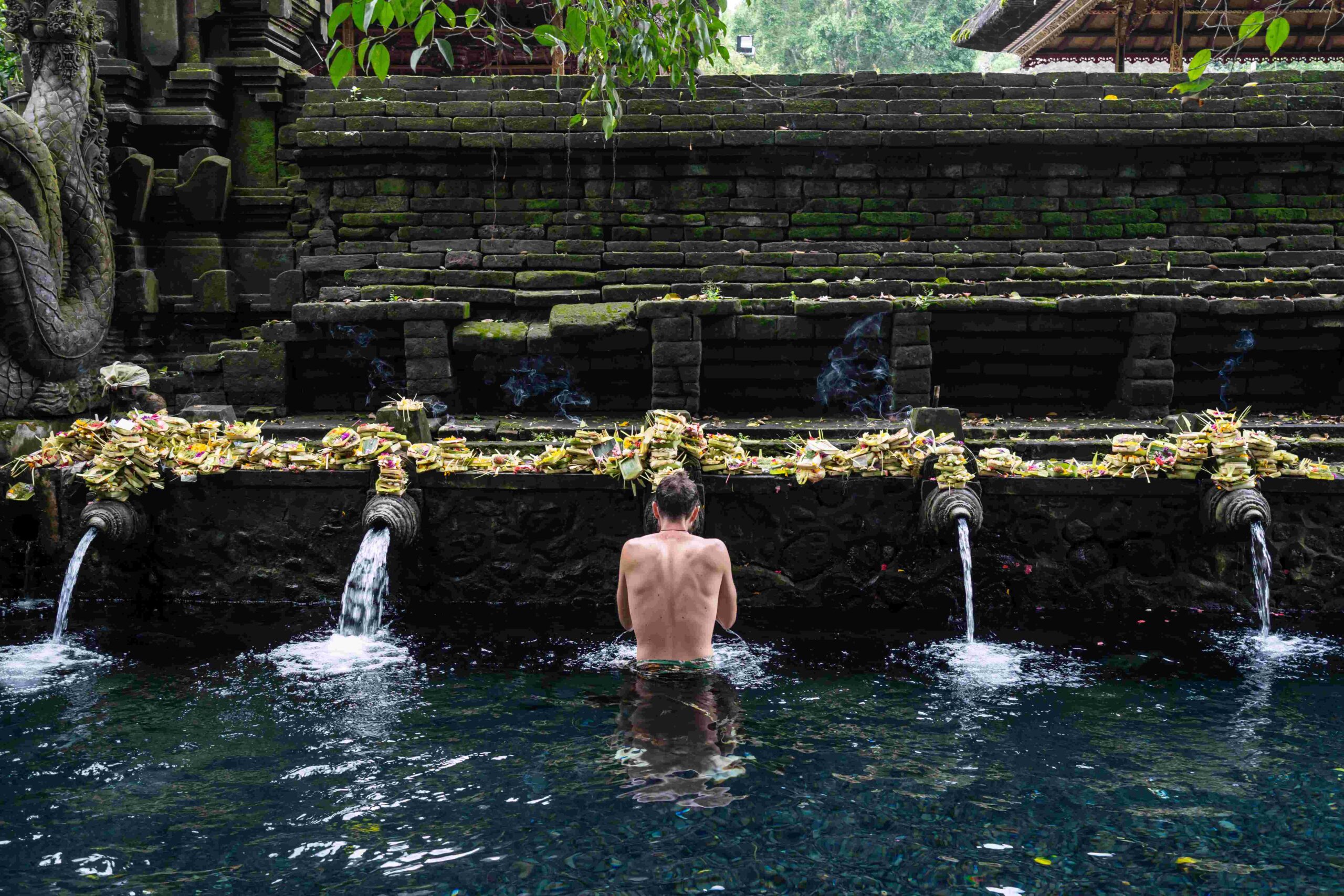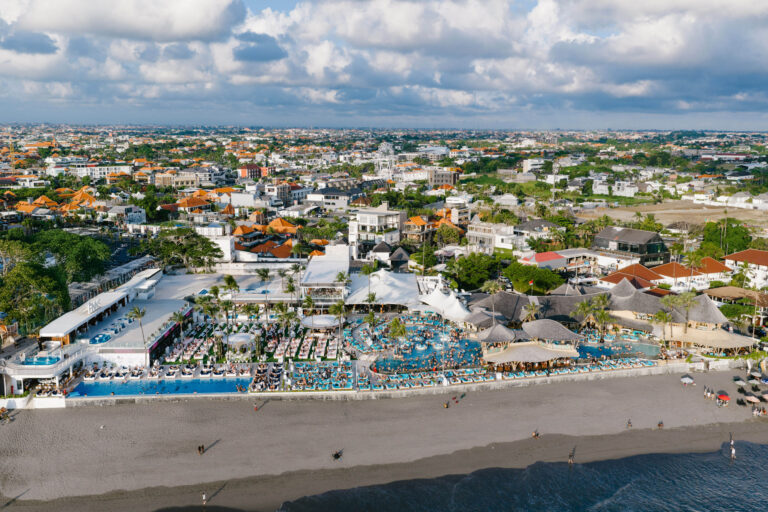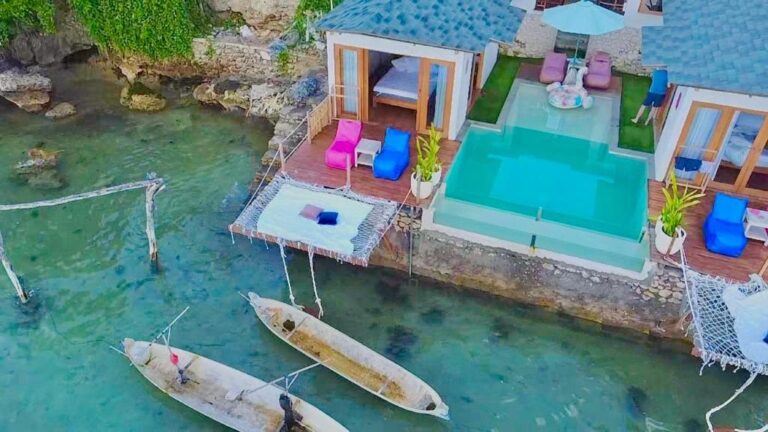Tirta Empul is one of Bali’s best-known temple sites and it’s dedicated to the Hindu purification rituals that take place there.
Visitors are welcome to visit the temple and it’s one of the most interesting places to see locals enjoying their relationship with their gods and the world around them.
Our guide to Tirta Empul will help you get the most out of a visit here.
Where Is Tirta Empul Temple?
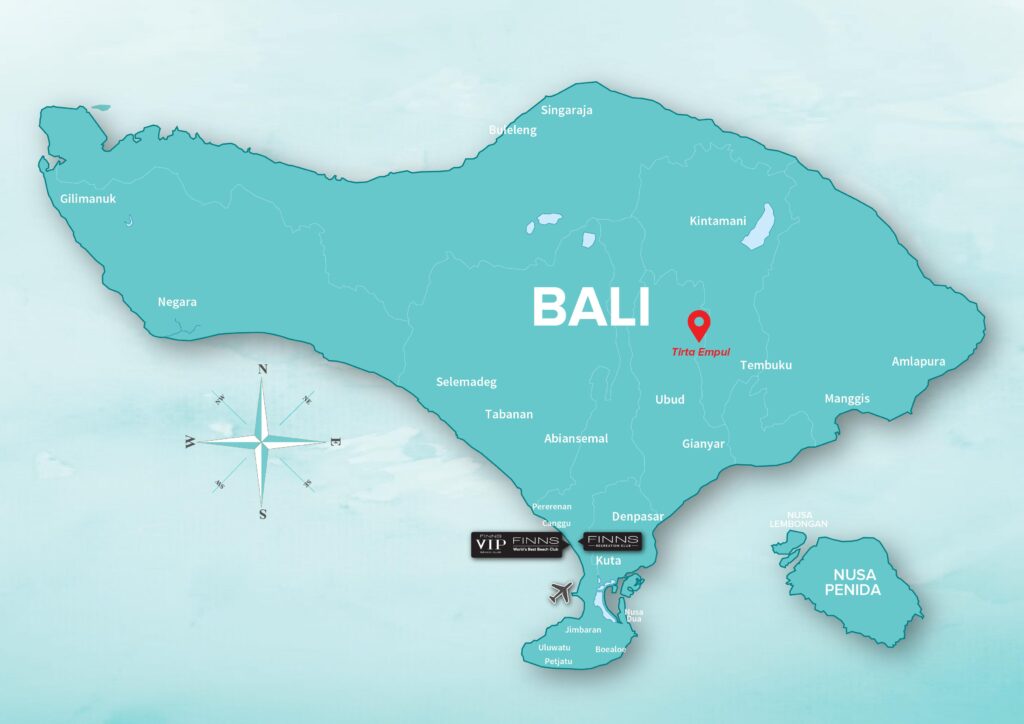
The Tirta Empul Temple Complex is located in the village of Tampaksiring which is outside of Ubud Town Center in the Gianyar Regency.
The Tirta Empul Temple Location is Tampaksiring, Gianyar Regency, Bali 80552, Indonesia
How To Get To Tirta Empul Temple

If you’re in Ubud already, then the best way to get out to the Tirta Empul Temple is to take a Grab or Gojek or join one of the organized tours of the temple.
For those coming from further afield an organized tour or a private car and driver is going to be ideal.
We can recommend using a tour service for this temple as it means you will be supplied with a local guide who can help you make the best sense out of what you see and assist you with any questions you might have.
It’s not expensive to join a tour of Tirta Empul and in our experience, the tours will usually take in other sites and temples around Tirta Empul too, which can help you get the most out of a day around Ubud.
When Is The Best Time To Visit Tirta Empul Temple?
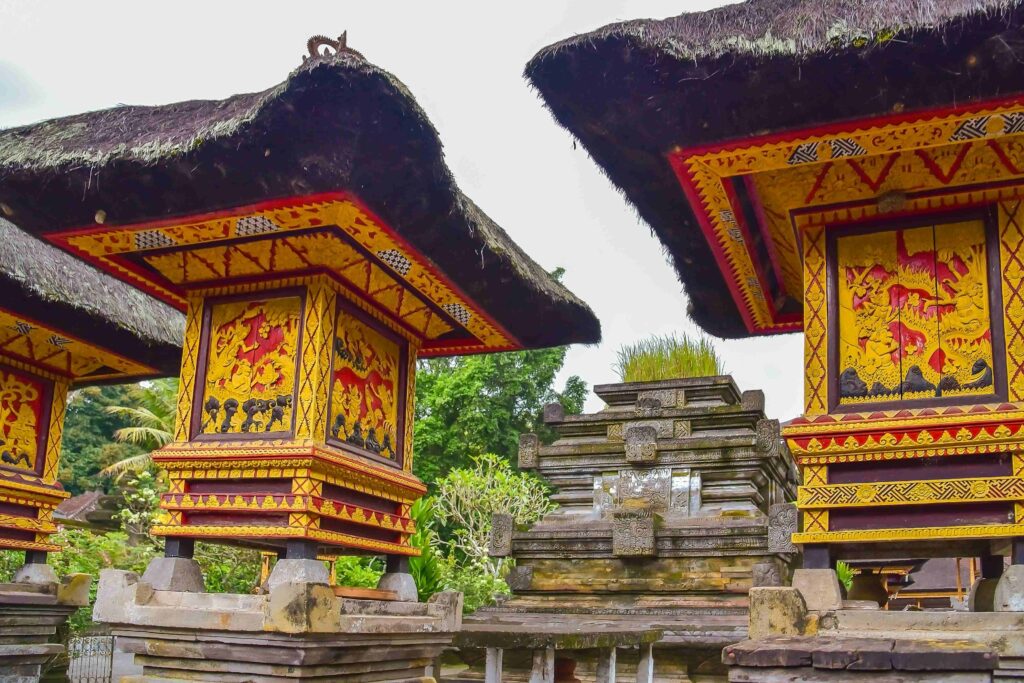
There is no “best time of year” to visit Bali, thanks to the island’s location in the tropics, the weather here is warm and pleasant all year round and that includes the weather at Tirta Empul.
Sure, it might rain a little bit more during the rainy season, but we still see an average of 9 hours of sunshine a day during that time.
It is a little hotter and more humid in the wet season, but there are also fewer crowds and flights and accommodation tend to be cheaper because it’s also the low season.
Conversely, it will be a bit cooler, less humid and have less rain (though it does still rain) during the dry season but you will have to pay more for your Ubud hotel or resort and your flight to Bali.
You may also find it harder to make reservations at your favourite restaurants and you might need to deal with bigger crowds at the busiest temples such as Tirta Empul.
What Are The Opening Hours At Tirta Empul Temple?
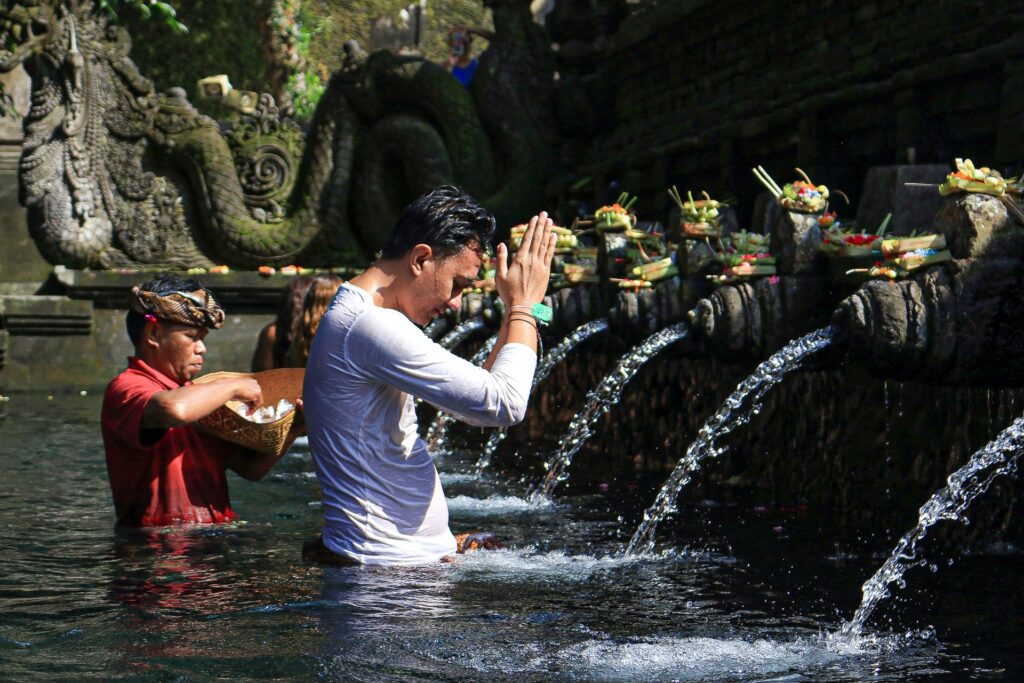
As with all sites in Bali, this temple is closed for Nyepi (the national Day of Silence that marks the beginning of the Hindu New Year).
Other than that, it is open to paying visitors from 7 a.m. to 7 p.m. every day of the year.
This is unusually generous for a temple’s opening hours and it means you can easily fit a visit to Pura Tirta Empul Temple into a day out around Ubud.
We should note that local Hindus are free to spend time in the temple without any time constraints whatsoever. Hindu spirituality is not on the clock.
What Is The Entrance Fee For Tirta Empul Temple?

The entrance fee is, of course, subject to change at any time but the current fee as we go to press is 50,000 IDR for an adult, 25,000 IDR for children under 11 and children under 5 are admitted free.
Local Hindus do not need to pay an admission fee to enter this place of worship, of course.
Your entrance fee is used towards the upkeep of the grounds and to ensure that the temple complex is preserved for future generations.
Please note that if you plan to use the purification pools then you may be able to do so, you must seek permission first – your guide may be able to arrange this, (there’s a very calm and relaxing atmosphere around the pools) but you must rent a bathing sarong (for an additional 10,000 IDR) and if you need a locker, that’s an additional 15,000 IDR.
Your entrance fee includes the rental of a standard (but not for bathing) sarong to wear while exploring the grounds. You can pick these sarongs up at the entrance to the central courtyard.
About Tirta Empul Temple
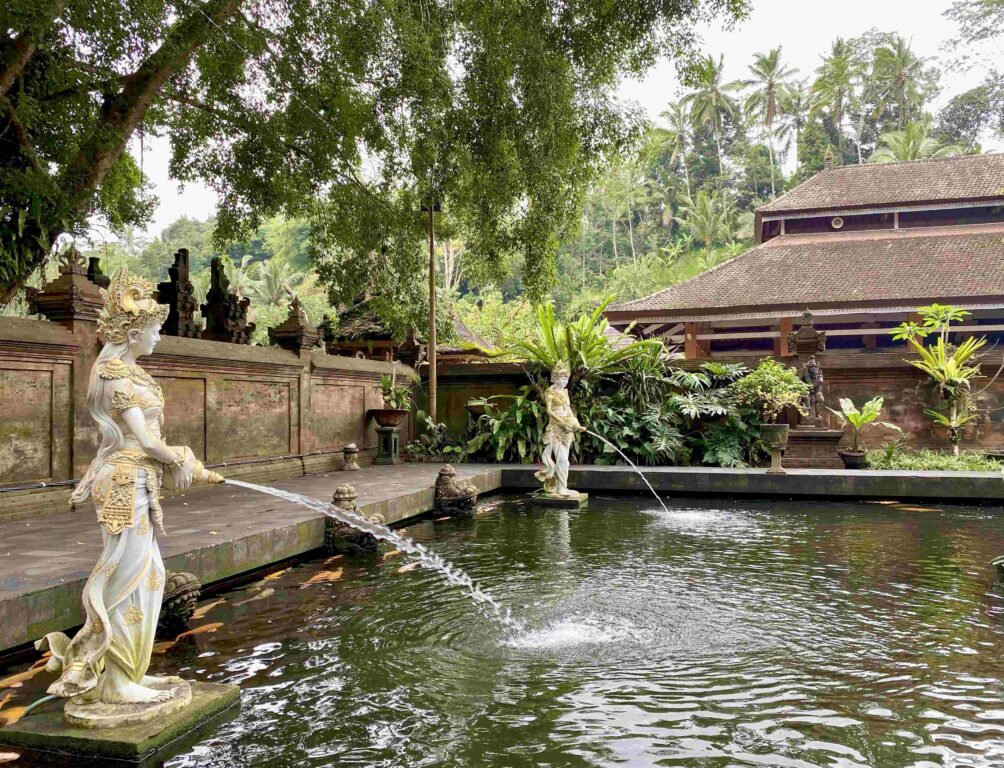
The temple complex is split into three divisions (front, secondary and then inner courtyard).
You arrive before the courtyards in lush tropical gardens and follow pathways past statues and vegetation through the candi bentar (temple gate).
Follow the path to the right to join the people waiting to participate in the purification ritual at the bathing pools.
Just be aware that if you do decide to bathe, the last 2 water spouts out of the 13 spouts there are reserved for bathing the dead for funeral rituals. So, don’t bathe under them.
The Legend Of Tirta Empul Temple
It is said that there was once a Balinese ruler called Mayadenawa who defied Hindu traditions.
Thus, the God Indra sought to subdue this king and his troops met those of Mayadenawa in battle.
Then Mayadenawa poisoned the local spring to kill Indra’s troops, but Indra thrust his staff into the ground at the place that would become Tirta Empul, purified the water and brought his troops back to life.
Mayadenawa was then vanquished and a temple was built on the site of the battle.
This battle is so legendary in Bali that it also inspired the Balinese holy days of Galungan and Kuningan which are celebrated all over the island.
Photography At Tirta Empul Temple
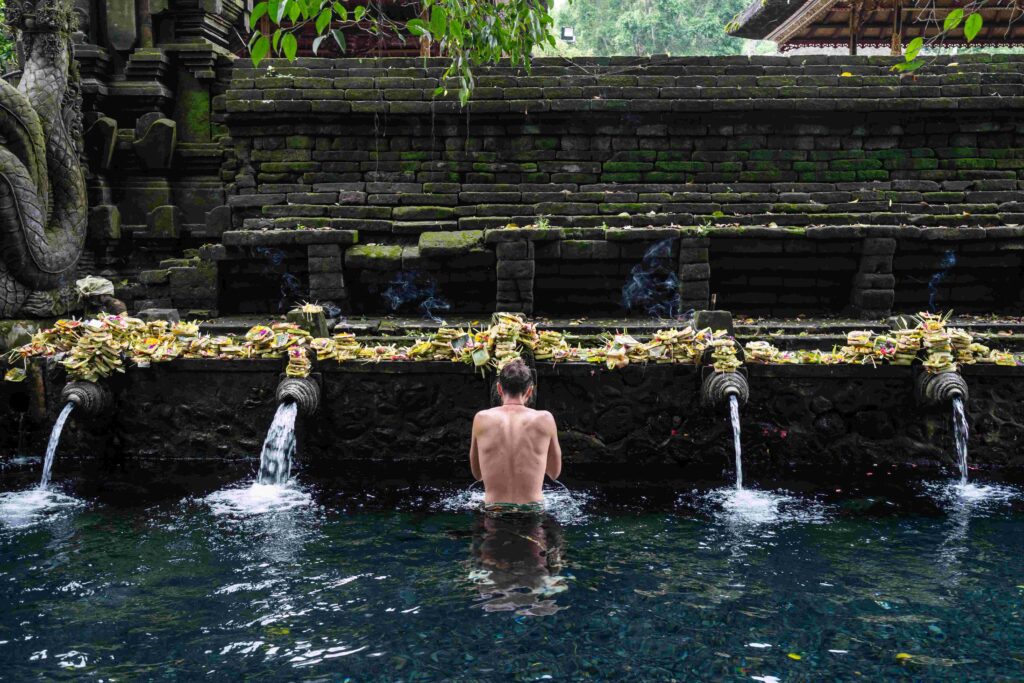
Tirta Empul is a photographer’s dream to some extent. The area around the central courtyard is full of exquisite architecture and the holy water spring is, of course, a fascinating place.
However, that doesn’t mean you can throw all caution to the wind and shoot any way you want to, we’ve got some tips for getting the most out of your trip to Tirta Empul without getting into any trouble.
-
Don’t take pictures of people praying or meditating, this is just a matter of respect. People who are involved in their spiritual practices should be allowed to do so in peace.
-
Do bring a wide-angle lens, there are parts of any temple grounds that are tight spaces and you will find that a wide-angle lens helps to open them up and it’s also much easier to capture the whole of Tirta Empul in a wide-angle view.
-
Don’t use flash indoors. It’s fine to use flash outside for almost any purpose but it’s not polite to use flash inside any buildings.
-
Do bring a tripod. You will get better images if you shoot from a tripod, particularly if you want smooth water or flowing cloud effects. Just make sure to be considerate about where you put your tripod.
-
Don’t climb on things or move things to get better shots. A temple is a holy place and that means you have to work with the environment, you can’t just interfere with things in the environment to improve your photographs.
-
Do bring an ND filter and a Circular Polarizer – these two filters can help you get longer exposures and help improve the quality of both sky and water in photographs.
Seek permission before you use your drone – the drone rules in Bali are pretty minimal and it’s easy to use a drone here, however, you must get permission from the temple authorities before you fly over any temple or you can get into trouble.
Is The Water Safe At Pura Tirta Empul Temple?
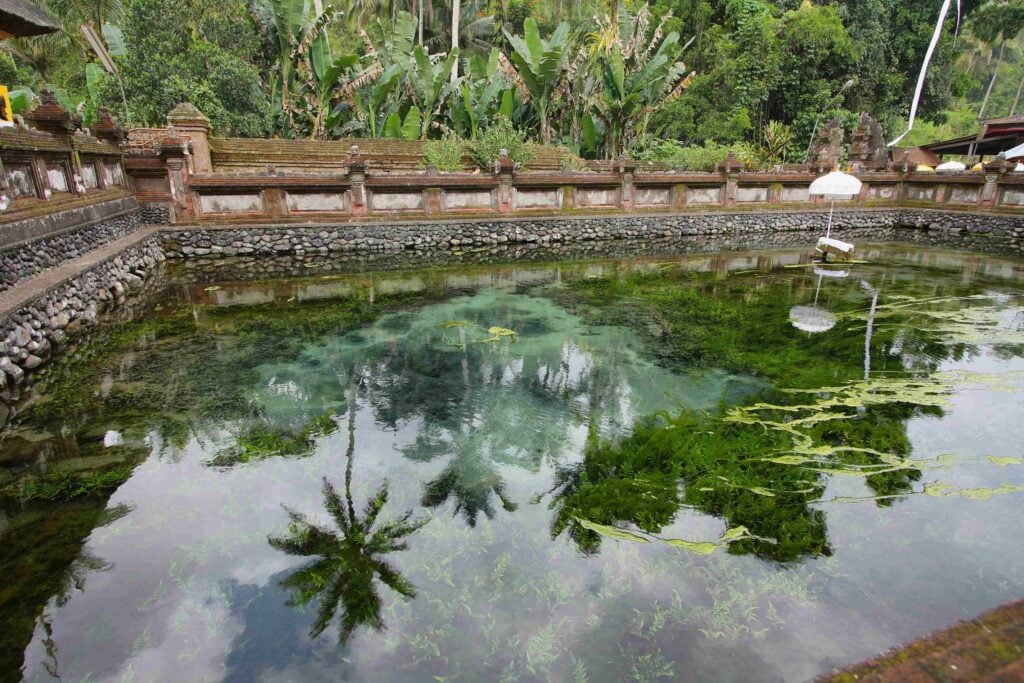
There were some suggestions back in 2017 that the Tirta Empul Spring was becoming a poisonous spring due to E. coli contamination.
The Balinese authorities did investigate these allegations and the temple has been given a clean bill of health.
Given that thousands of people come to Pura Tirta Empul Temple each year to bathe in the holy spring water, we’re positive that if there were any major danger to human health, it would have become apparent by now.
It’s also worth noting that you’re not obliged to bathe at the holy water temple, it’s entirely optional and you can visit Tirta Empul and stay completely dry.
What Is The Dress Code For Tirta Empul Temple?

The dress code at Pura Tirta Empul Temple is the same as at all temples in Bali.
You are required to dress modestly and in practice, this means you must have your shoulders covered and your legs covered.
The locals achieve this modest effect by wearing a shawl and a sarong. The rental of a sarong is included in the ticket price for Pura Tirta Empul Temple and you can pick it up on the way into the temple.
We should remind you that this sarong is not for bathing in the purification pools and you will need to rent an additional sarong to enjoy the holy spring water.
Bali has had real problems in recent years with visitors disrespecting holy sites and not obeying the dress code at Tirta Empul could see you asked to leave the temple or even being arrested and then deported from the island.
So, we would strongly encourage you to stick to it.
We should also note that menstruating women are meant to stay out of holy sites during their period as Hinduism considers them to be “unclean”.
You certainly shouldn’t enter the purification pools at the Holy Spring Water Temple if you are menstruating.
Hotels Near To Tirta Empul Temple
Padma Resort, Ubud

This luxurious resort is intended to help celebrate the timeless green scenery that surrounds its 149 rooms and suites.
It’s perfectly located for sightseeing around Ubud and visitors will enjoy amazing restaurant facilities too.
Where Is It? Padma Resort Ubud Banjar Carik, Desa, Puhu, Kec. Payangan, Kabupaten Gianyar, Bali 80572, Indonesia
Puri Gangga Resort, Ubud
Out in the fields with an amazing view of the Pura Gunung Kawi Sebatu holy temple is the Puri Gangga Resort.
Their luxury spa facility is the envy of many a boutique resort and if you want somewhere completely peaceful to rest your head, this is a great choice.
Where Is It? Sebatu, Tegallalang, Gianyar Regency, Bali 80561, Indonesia
Alila Ubud
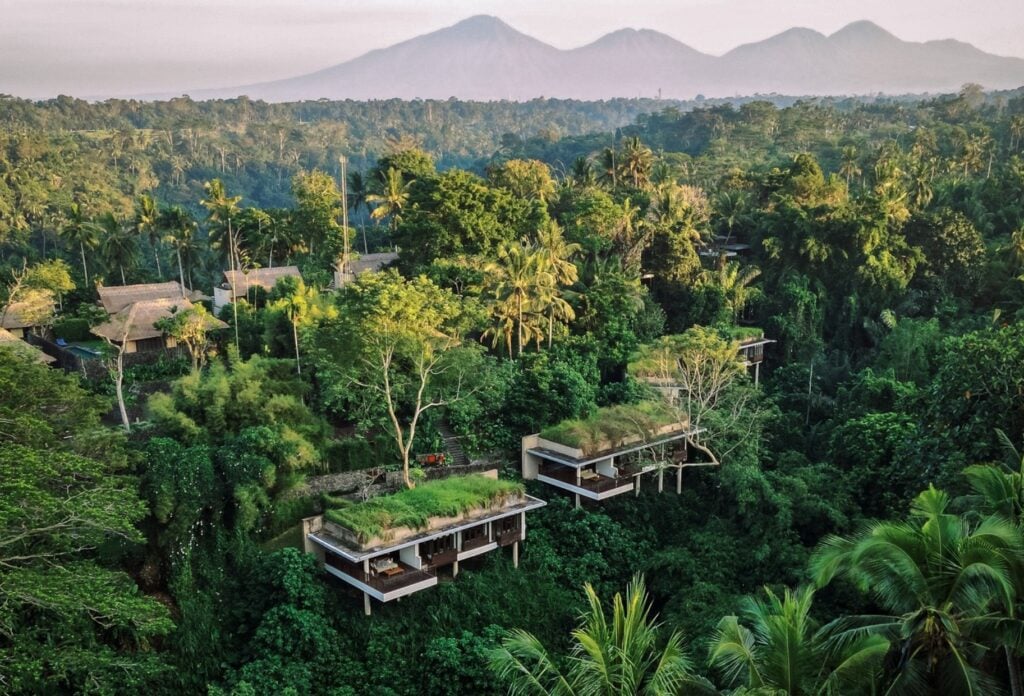
This amazing jungle resort over the Ayung River offers spectacular views of the jungle canopy and local plantations.
The rooms here are all designed in traditional Balinese style with all the modern conveniences you could possibly need.
Where Is It? Desa, Melinggih Kelod, Payangan, Gianyar Regency, Bali 80572, Indonesia
Amori Villas
If you want a wellness resort then this lovely villa complex might be the perfect place between temple visits.
They have an amazing yoga retreat and some of the nicest, freshest meals around.
Where Is It? Jl. Dukuh Kawan, Pejeng Kawan, Kec. Tampaksiring, Kabupaten Gianyar, Bali 80552, Indonesia
Sankara Ubud Resort
This villa complex is all about providing you with the space you need in perfect privacy.
Individual gardens and infinity pools are standard at this artistic and exciting resort.
Where Is It? F778+F7P, Jl. Cempaka, Kumbuh, Jl. Cempaka, MAS, Ubud, Gianyar Regency, Bali 80571, Indonesia
Other Attractions Near Tirta Empul Temple
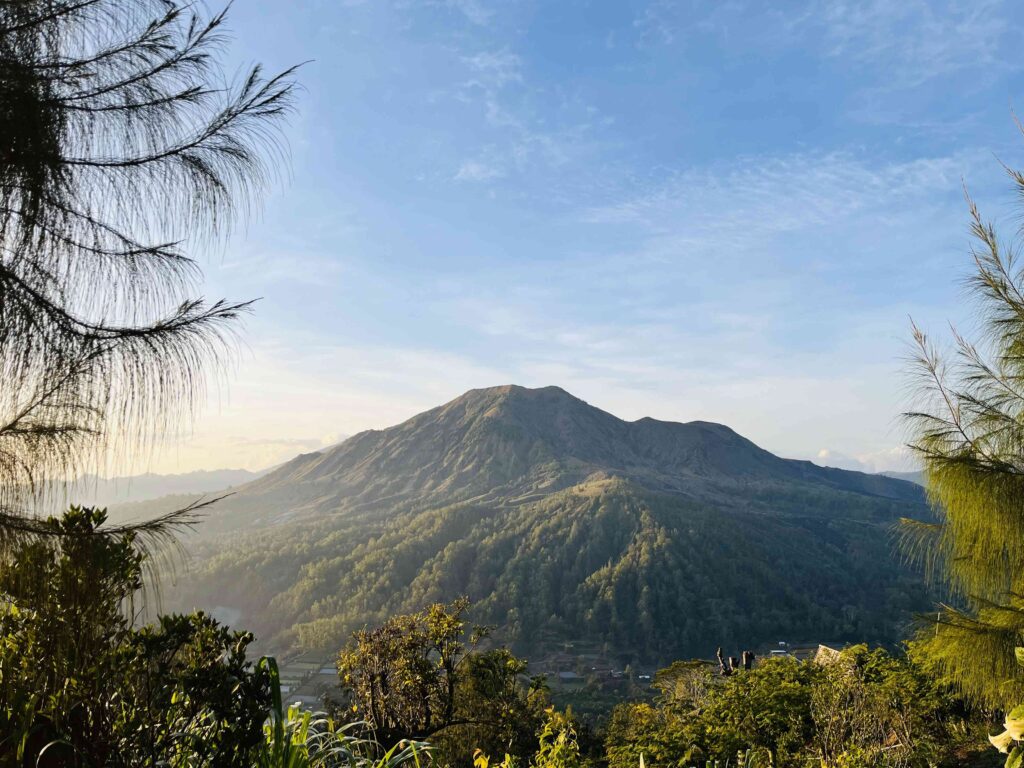
Mount Batur – you’ll need to travel a bit further afield to Kintamani to visit this stunning active volcano but it’s worth the journey. If you hike up the mountain, you can enjoy an amazing view from the caldera.
Campuhan Ridge Walk – if you want a less challenging hike, then head to Central Ubud and try this Campuhan Ridge Walk at sunset, you get stunning views of the local rainforest and rice fields. (We’ve got a list of the best hiking trails in Bali too).
Gunung Kawi Temple – this incredible temple is carved out of the rock of a pair of opposing cliff faces. It’s thought that the shrines here are dedicated to the Ubud Royal Family, but there’s quite a bit of mystery involved too.
Tegalalang Rice Terraces – these incredible rice terraces are among the most Instagrammable sites in Bali. They are a fantastic way to connect with the agricultural traditions and culture of the island.
Ubud Monkey Forest – there are many places to see monkeys and temples in Bali but very few are as famous as the Sacred Ubud Monkey Forest Sanctuary. There are hundreds of mischievous monkeys at this site.
Ubud Art Market – this is the largest and most popular art market in Bali and if you’re in the mood for sniffing out a bargain, this could be the perfect place to do it. Almost everything at this market is made in nearby villages.
Goa Gajah (Elephant Cave) – the connection with elephants at this cave is poorly understood but there’s no doubt that this is one of the more spectacular temple sites in Bali.
Ubud Royal Palace – Bali used to be a series of kingdoms and its royal families remain even if only in a ceremonial fashion. The Ubud Royal Palace is a great place to explore how local royalty lives.
FAQs
Is Tirta Empul Worth Visiting?
Yes! Tirta Empul Temple and its holy spring are an incredible place that offers visitors a serene and pleasant atmosphere, extraordinary architecture and insight into a ritual of purification that you cannot find easily elsewhere in Bali. Most people consider it to be one of the best temples in Ubud.
To the Balinese Hindus, it’s one of the most important religious and cultural sites in the land and to visitors, it’s one of the most fascinating places on the island.
Given how easy it is to get to Tirta Empul Temple from Ubdu, if you’re in Central Bali this should be a no-brainer part of your itinerary.
What Is The Significance Of Tirta Empul Temple?
Tirta Empul is a place of purification for the Balinese Hindus. They come to bathe in the holy water that flows from the spring and to visit the large Hindu shrines at the water temple.
Local Balinese place great stock in the natural spring water and the cleansing ceremony that is held in the holy waters of this temple is said to offer great spiritual benefits to the individual.
How Much Does It Cost To Go To Tirta Empul?
It’s just 50,000 IDR for adults and 25,000 IDR for children to enter the temple. Any other costs you incur are likely to be related to transport and food/drink.
What Is The Name Of The Temple On The Water In Bali?
While there are many temples that might be considered “on the water” in Bali such as Tanah Lot or Tirta Empul, the temple you are most likely thinking of is Pura Ulun Danu Beratan.
The Pura Ulun Danu Beratan is found in North Bali on the shores of Lake Bratan and during the rainy season, it can appear like it is actually floating on the waters of the lake.
What Is The Meaning Of The Holy Water Temple In Bali?
The name “Tirta Empul” translates to “water gushing forth from the Earth”. The water is said to spring from the Great God Vishnu and thus, the water is considered to be holy.
Final Thoughts On Tirta Empul Temple
Tirta Empul Temple, the holy spring water temple, is one of the busiest water temples in Bali and that’s because it’s a truly sacred site.
This large temple complex is a must-see for visitors interested in the spiritual nature of the island. It’s an amazing part of the cultural heritage of Bali.
While Hindu worshippers come for the magical powers and healing properties of the water flowing through the temple area, it’s also a tourist destination for its relaxing atmosphere and pleasant local community.

